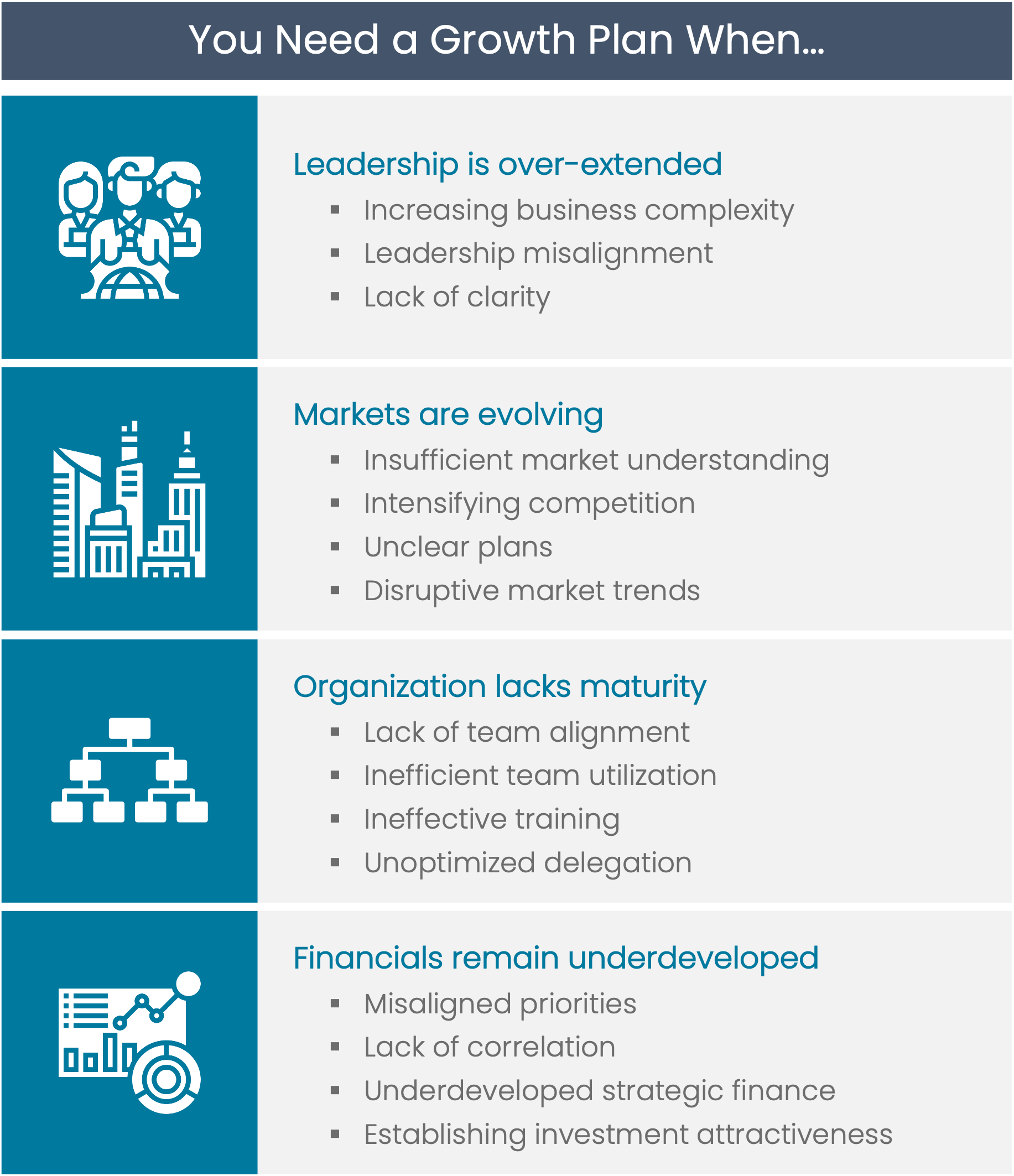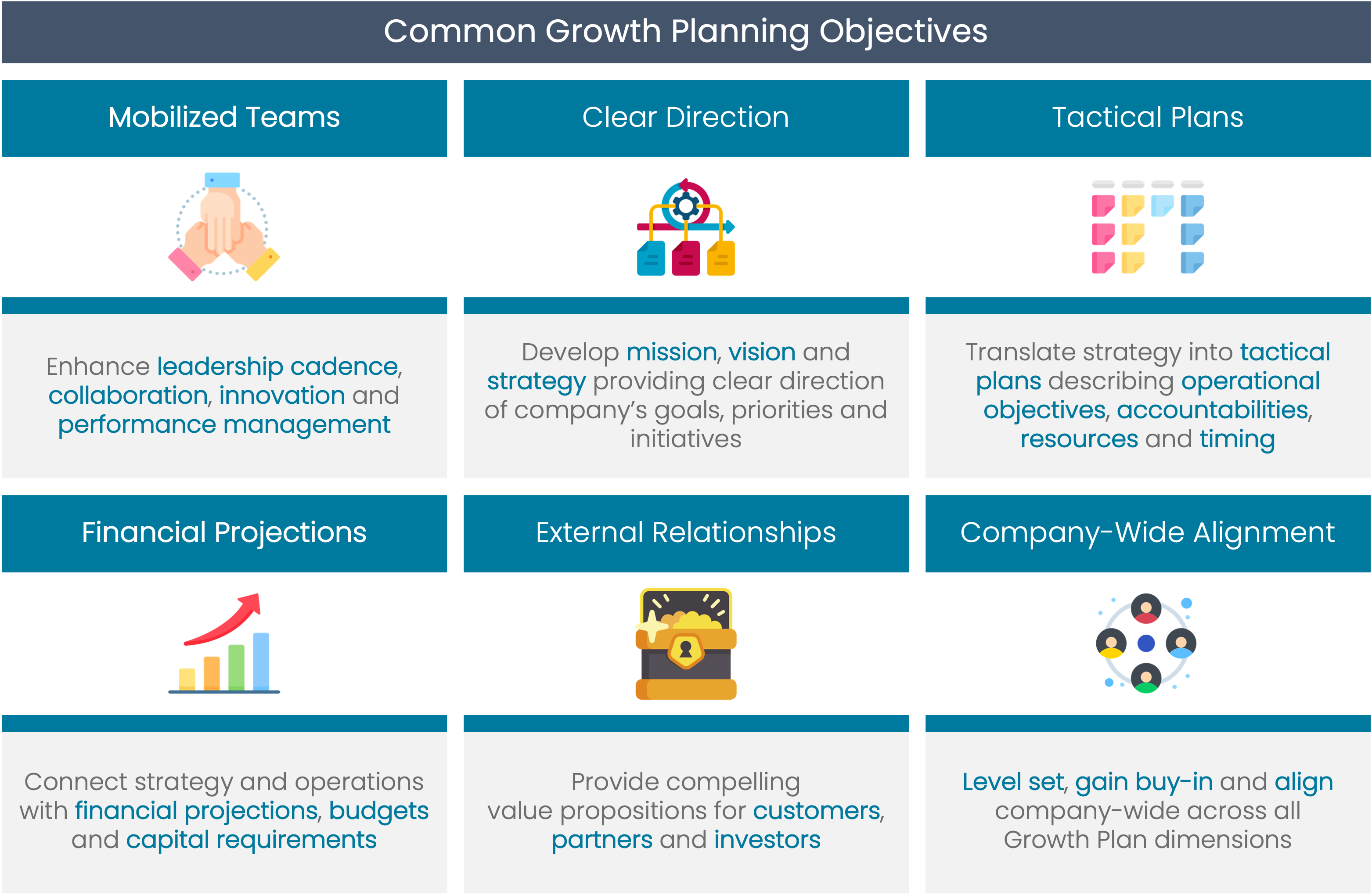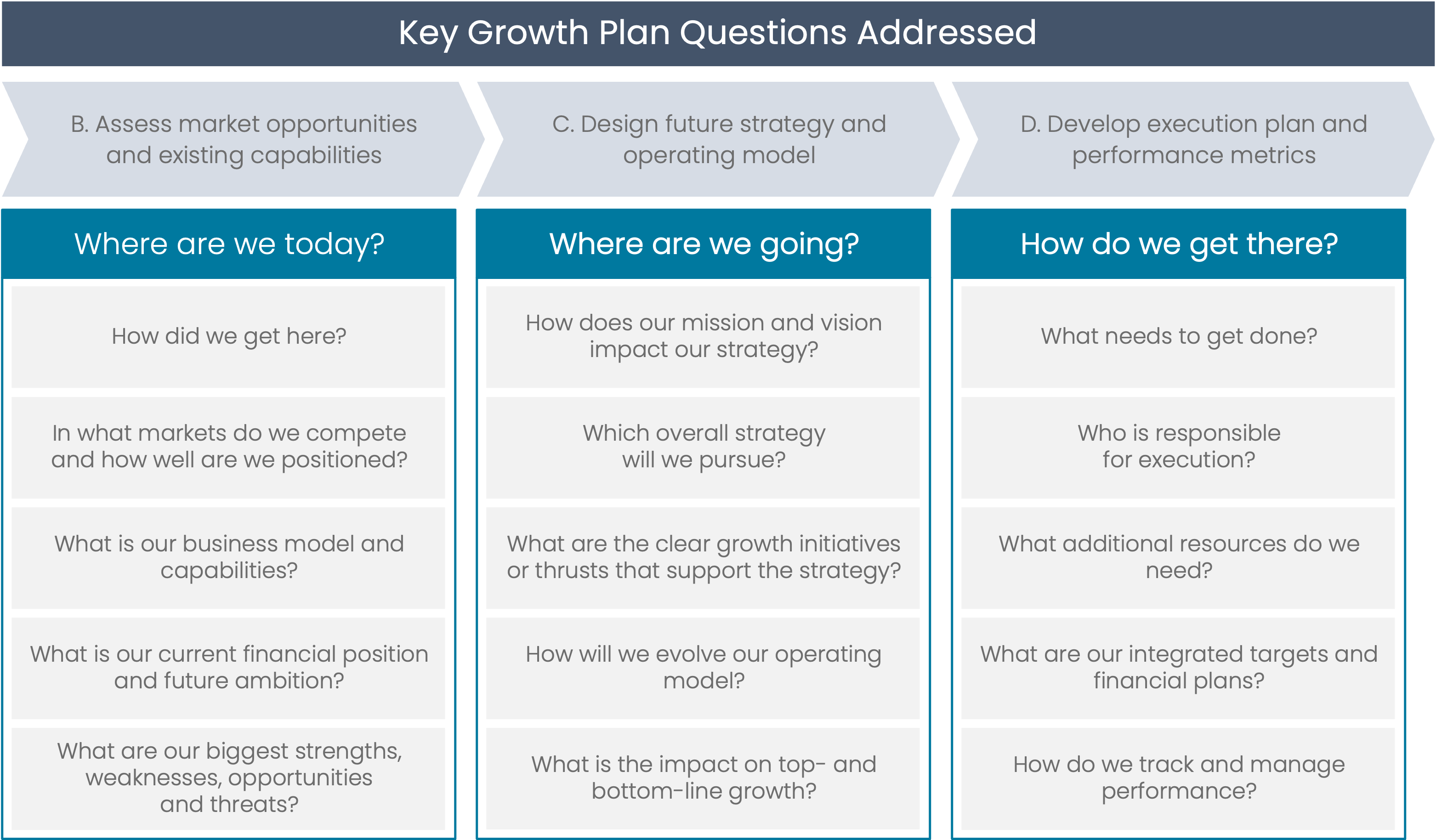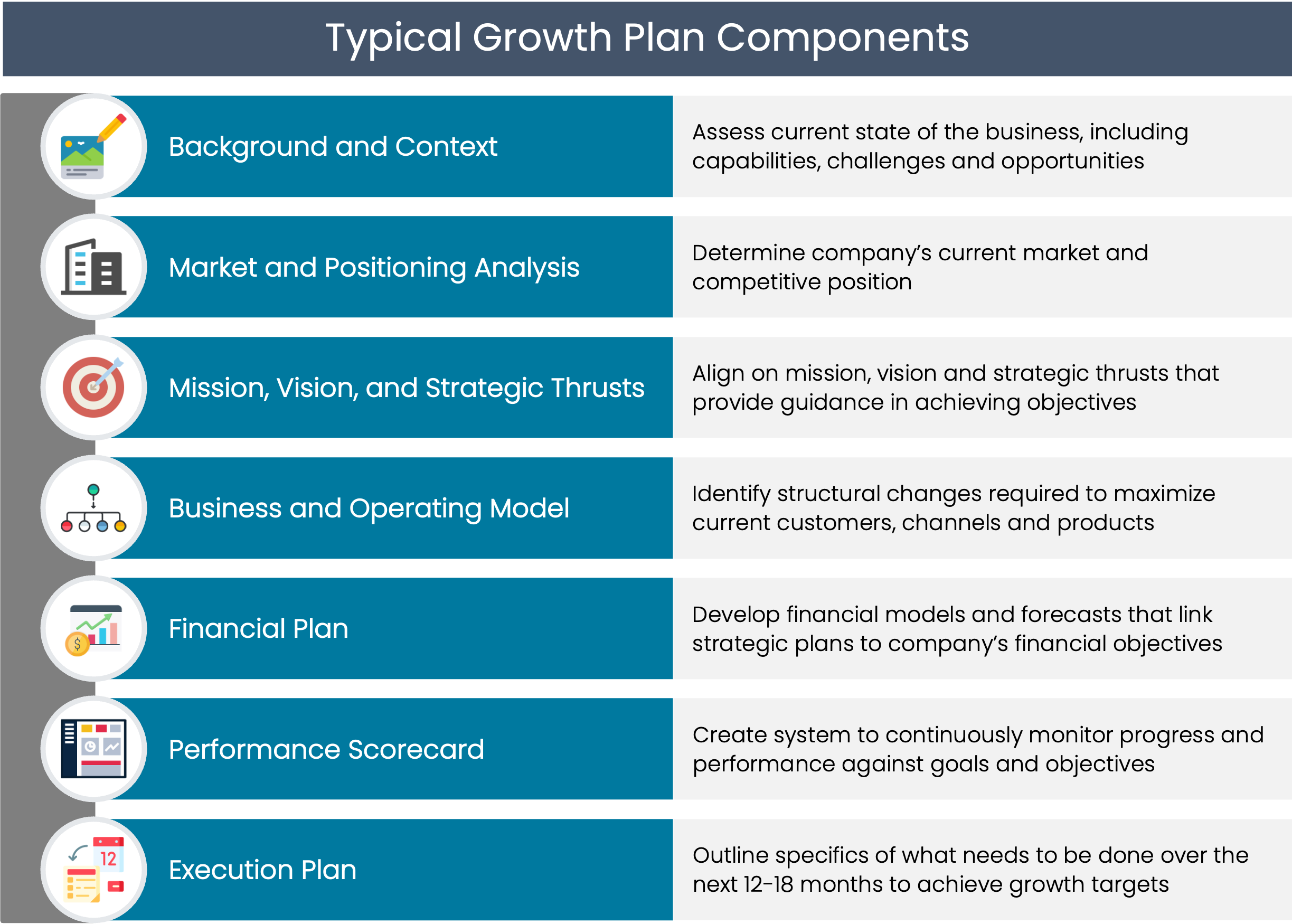
Are you struggling to accelerate your company’s growth and value? Perhaps you’re the founder, CEO or leadership team member of a venture-backed business. You and your team have done a great job developing your company from early stages to where it is today, and you have significant growth aspirations going forward.
However, as the company has gotten larger and more complex, you’re finding it increasingly difficult to continue to grow effectively. It’s possible that your business has become more reactive to putting out growth-related fires, rather than proactively building the capabilities needed to scale. Maybe everyone has a different view of the company’s strategy and top priorities. Perhaps the leadership team needs to be involved in too many decisions, resulting in never-ending meetings debating low-priority issues. Teams may believe that they are over-delivering, yet the business doesn’t seem to be making as much progress as you would expect. Collaboration among teams is ad-hoc, resulting in frequent surprises from different parts of the organization accompanied by lots of finger-pointing. Or your board members may be asking for clarity on the company’s forward-looking objectives and priorities, but you don’t have compelling and up-to-date plans to share with them.
In addition to the above, maybe your company needs to pivot its strategy, moving away from what’s not working to a business model and offerings that better fit evolving market opportunities. Perhaps you’re growing so fast that you want to put in place the capabilities you think you’ll need when you are two or three times your size. Or possibly you’re preparing for your next round of financing, and you need to be able to communicate a compelling story to potential investors about how you plan to use the funds to achieve your next stage of growth and value.
Whatever the situation, you’re not alone – these are challenges that every CEO must address as their companies grow and mature. Developing a growth plan and implementing an ongoing growth planning process can be a powerful catalyst for addressing these issues, making sure your company is prepared to grow effectively over the next few years. Let’s talk about what a growth plan is, and why it might be the right time to put one in place.
You need a growth plan when…
When do you need a growth plan? The short answer is when increased size and complexity outrun the leadership team’s abilities to address issues and manage growth. To what degree are you facing any of these specific leadership, markets, organization or financial growth-related challenges?

- Over-extended leadership. The intricacies of growing the business due to increasing business complexity may have extended beyond the leadership team’s ability to be in every meeting and make every decision. Leadership misalignmentmay be evident with differences in perspective, driving the leadership team to call meetings to resolve them. And a lack of clarity could mean it is unclear who is in charge of certain issues and opportunities.
- Market evolution. An insufficient market understanding could be clouding a clear, shared point-of-view on your business opportunities. Existing competitors may be evolving their offerings, while new competitors could be emerging, intensifying competition. Your next growth opportunities might not be clearly definedwith coordinated attack and funding plans. Technologies, business models and regulatory environments could be creating potential market disruptions.
- Organization maturity. Lack of team alignment may cause functional teams to call constant meetings to make progress, with unclear objectives. Teams may be underutilized, with inadequate leverage and lack of delegation. Ineffective trainingcould mean that new hires are not getting the training, support and clear metrics they need to achieve their business goals. And you may find team members rising up to take urgent-need rolesrather than those for which they are best suited.
- Underdeveloped financials. Finally, you may find that strategy, operational priorities and financial expectations are misaligned. It could be difficult to explain current business performancewith the existing financial reporting. There may also be an unclear view of future funding requirementsand where investments need to be made to achieve expected financial results. For companies seeking to raise additional capital, you may require a clearer articulation of your growth plan, including the planned use of funds, in order to establish investment attractiveness and secure the next round of funding.
Common growth plan objectives
Every successful company faces a shifting set of the above challenges as they grow and become more complex. Growth plans help clarify goals and align execution in order to enable the next stage of your company’s growth by connecting and aligning around the strategic, operational and financial dimensions of the business. Common objectives for creating a growth plan include mobilizing teams, setting clear direction, developing tactical plans, connecting financial projections, enhancing external relationships, and achieving company-wide alignment.

- Mobilized teams. Most companies find that the process for developing their growth plan is a powerful catalyst for enhancing their organization’s capabilities and mobilizing their teams. Specific objectives often include improving the leadership team’s weekly decision-making cadence, increasing collaboration between business functions and team members, spurring innovation, and setting the foundation for aligned OKRs (objectives and results) or other performance management practices focused on achieving collective objectives.
- Clear direction. As your company has grown, your team’s shared view of what you’re seeking to accomplish may have gotten somewhat blurred by the addition of team members with different experiences and perspectives. Your growth plan provides an excellent opportunity to paint a clear direction going forward, including confirming your company’s mission and vision, and articulating a compelling strategy of your company’s goals, priorities and initiatives for the next several years. The result is often a renewed sense of purpose, with clearly defined value propositions that identify where the business intends to have the greatest impact in the market, supported by a framework to guide the business and measure progress.
- Tactical plans. A brilliant strategy is worthless without the ability to execute. Your growth plan should include tactical plans that describe what needs to get done to support the strategy and your performance objectives. These execution plans should include transparency on operational objectives, roles and responsibilities, additional headcount or funding requirements, timing, and the explicit performance metrics that you plan to achieve over the growth plan time horizon. These, in turn, result into much clearer accountabilities, increased delegation, and improved ability to scale the organization.
- Financial projections. It’s critical to connect your strategy and operational plans with the financial results you expect to achieve, including revenue, profitability, capital requirements and detailed budgets. Think in terms of the financial physics of your business, identifying the strategic levers that both drive growth and manage costs. Cost cutting is not the focus of most growth companies; rather, focus on the best ways to grow efficiently, expanding margins as you increase scale. Confirm business rationale for investments, including amount, timing, and how incremental spending enables strategic initiatives and supporting tactical plans.
- External relationships. While you may think of your growth plan as a deliverable primarily intended for internal stakeholders, the best growth plans are powerful tools for communicating compelling value propositions for customers, partners and investors. This includes communicating an offering roadmap that external stakeholders can buy into, as well as clear rationale for how raised funds will be used that compels investor support.
- Company-wide alignment. Bringing it all together, the growth planning process is a great way to level set expectations, gain buy-in on priorities, and align everyone on your team on a company-wide basis. This isn’t just about the leadership team, but also making sure that the board understand and supports where the company is going, and that all team members have the guidance they need to do what you expect of them.
Questions to ask
Regardless of your particular objectives, every growth plan needs to address substantive questions about where the company is today, where you are going next, and how you are going to get there. As you think about kick-starting your growth planning process, consider the best ways for your team to answer these questions.

- Where are we today? Start by assessing your current market opportunities and existing capabilities. Ask yourself, how did we get to where we are today? In what markets do we compete, and how well are we positioned against competitors and substitutes for our products and services? How might we describe our business model, including the capabilities that we have developed over time? What is our current financial position, and what would we like to achieve in terms of revenue and profitability growth over the time horizon of our growth plan? In the context of the above, what are our key strengths, weaknesses, opportunities and threats?
- Where are we going? Next, work together as a team to design your future strategy and operating model. Address questions like how does our mission and vision impact who we are, and thus our strategy? What is the overall strategy we plan to pursue over the next few years? What are the specific growth initiatives or cross-functional strategic thrusts that support the overall strategy? How do we need to evolve our operating model to be consistent with our growth objectives and strategy? And what do we expect will be the financial impact on our top-line and bottom-line growth?
- How do we get there? Finally, develop the execution plan and performance metrics that guide your entire company on the journey forward. This needs to include asking, what specifically needs to get done and when? Who is responsible for each part of the execution? What additional headcount, funding or other resources do we need? How do our execution plans integrate with our financial targets? And what are the best ways to track and manage performance over time?
Pulling deliverables together
The most visible output of your growth planning effort will be a growth plan presentation that tells a compelling story about where your company is today, where it is headed, and how you plan to get there. A potential table of contents might include background and context; market and positioning analysis; mission, vision and strategic thrusts; business and operating model; execution plan, financial plan; and performance scorecards. However, there is no right or wrong structure for your growth plan – consider this a starting point, which you should adjust to meet your specific situation and needs.

- Background and context. Assess current state of the business, including capabilities, challenges and opportunities. Details may include company history, core capabilities, organization, culture, and leadership team.
- Market and positioning analysis. Determine the company’s current market and competitive position, such as offerings, customers, channels, market size, competition, dynamics, and trends.
- Mission, vision and strategic thrusts. Align on mission, vision and strategic thrusts that provide guidance in achieving the company’s objectives over the time horizon of the growth plan. Consider including a discussion of market opportunity, a mission statement describing why your company exists, your vision of what you intend to achieve over the next several years, agreed-upon top-line, profitability and other performance objectives, the umbrella strategy, and the strategic thrusts describing the major components of the strategy.
- Business and operating model. Identify structural changes required to maximize current customers, channels and products. This may include describing the company’s go-to-market approach, offerings and value propositions, operations, partnerships, resources, revenue streams and cost models.
- Execution plan. Outline specifics of what needs to be done over the next six, 12, 24 and 36 months to achieve shared growth targets. This may include priorities for each strategic thrust, leadership cadence, activities, owners, and timing.
- Financial plan. Develop financial models and forecasts that link strategic plans to the company’s financial objectives. Components usually include forecasted P&Ls, balance sheets and cash flow statements, as well as funding requirements.
- Performance scorecards. Create system to continuously monitor progress and performance against goals and objectives. These include overall objectives, qualitative and quantitative metrics, performance targets, and dashboards.
Getting started
Making the commitment to developing your company’s growth plan is a major decision that generally requires sponsorship from the CEO, buy-in from the leadership team, and support from your Board. Addressing the questions of where we are today, where we are going, and how we are going to get there takes real work, and thus the scarce and valuable time of the leadership team and others within the organization.
Just as there is no set table of contents for a growth plan, there is no right or wrong approach for developing your growth plan. It’s conceivable that you could convene your leadership team offsite at a hotel for several days, work through each of the questions, and develop a growth plan that meets many of your current needs. A more likely approach is to develop your growth plan over a two-to-three-month period, perhaps leveraging an agile approach made up of one-to-two-week sprints focused on answering specific questions. Either approach leverages the experiences and knowledge that has been developed from across your company at this point of time, including previous external and internal analyses that have been completed.
In the longer run, growth planning is more than creating a single growth plan presentation. It is about developing a set of guidelines by which you and your team build your business on a daily basis. While you may start by creating a single document, your plan should consider creating a systematic and ongoing process that your leadership teams on a regular basis to actively plan and manage your company’s growth. Think of your growth plan as a seed from which a growth planning process emerges, that becomes a core capability that your business nurtures to tie together long-term objectives with short-term actions. The thinking, decision-making and alignment that comes out of this collective effort will provide you and your team with tremendous value over time.
We’ve developed the Growth Plan Lean Playbook to help CEOs, leadership teams and their advisors develop growth plans and begin to build robust growth planning capabilities that evolve over time. While every company’s situation is unique, this flexible agile-based approach provides a foundation of everything you need to get started. This includes a series of one-to-two-week sprints designed to be completed easily by leadership and their teams over a two-to-three-month period, including how-to-guides, templates, and examples to facilitate the work. Let us know how we can help you and your team get started with your growth planning process today.
